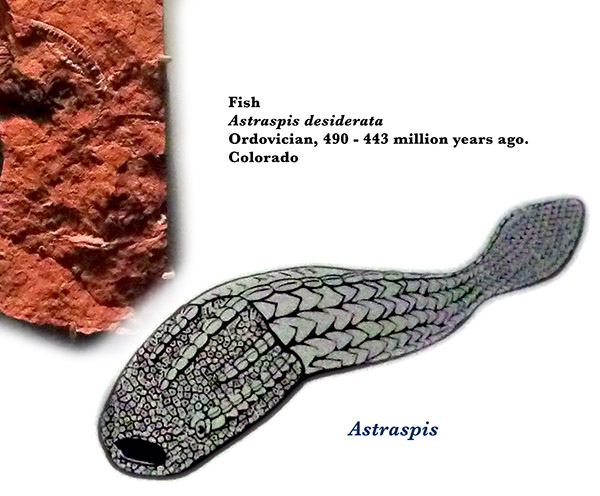First Fish, 525 - 518 mya, first bony fish about 420 mya |
||
By 518 million years ago, in the Cambrian Period, a creature now known as Metaspriggina walcotti swam in the oceans, and this creature was essentially a fish. It had eyes, external gills, and a notochord. This fish did not have bones or vertebrae, but neither did other Cambrian Period fishes such as Haikouichthys and Myllokunmingia (which may be even older, perhaps dating back to 530 million years ago). Bones and internal skeletons made of bones evolved from bony plates in the skin and cartilage, but that happened much later, perhaps around 480 million years ago when species such as Arandaspis came along. Arandaspis didn’t have an internal skeleton or a jaw, but it did have bony plates and scales. In the same strata of 480 million year old rocks where Arandaspis scales have been found, palentologist have found fossils of fish scales that look similar to modern shark scales, and this suggests that perhaps creatures with jaws were swimming in the seas of 480 million years ago (called Tantalepis fish), but palentologists are still looking for fossils of these earliest fish, which probably had cartilage rather than bones. So far, the earliest fishes with jaws for which we have good fossils are the armored placoderms of the early Silurian Period. Sacabambaspis, which lived in the Ordovician seas around 460 million years ago, is the oldest fully skeletonized vertebrate for which we have fossils, but Sacabambaspis was a jawless fish. Bony fishes, which are now the most common and diverse type of vertebrates on Earth, seem to have evolved about 420 million years ago, at the end of the Silurian or start of the Devonian Period. These are represented by species such as Andreolepis hedei and Lophosteus superbus. In summary: 1) Earliest fish appear sometime between 530 mya and 518 mya, in the Cambrian period |
|
Links about the first fishes: 1. The Oldest Fish in the World (Metaspriggina walcotti). 2. Science News Online has an article on Myllokunmingia and Haikouichthys, which seem to be tens of millions of years older than Metaspriggina walcotti. They are probably vertebrates, and might be fish. 3. Palaeos page about Acanthodi. (480 mya) 4. The Arandaspis. And Melbourne Museum's page about the Arandaspis. (480 mya) 5. Fantastic illustration of Sacabambaspis. (460 mya) 6. The Age of Fishes museum in Canowindra, New South Wales, Australi has a page about Bothriolepis yeungae. (360-370 mya), one of the most common and widespread placoderms.
|
 |
|||
| Display of an Astraspis desiderata fossil in the Field Museum of Chicago | |||
Back to the World History Timeline in English
|